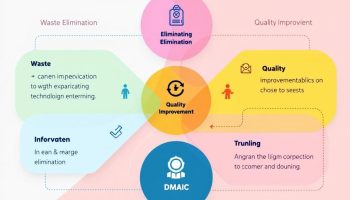
Lean vs. Six Sigma: Understanding the Differences
The main difference between Lean and Six Sigma lies in their core philosophies of process improvement. Lean focuses on eliminating waste and maximizing customer value through streamlined workflows. Six Sigma concentrates on reducing defects and minimizing process variation through statistical analysis and data-driven methodologies. Understanding these distinct approaches helps you strategically implement either or both methodologies to enhance operational efficiency and quality control.
Key Takeaways:
- Lean primarily targets waste elimination and workflow optimization from a customer value perspective
- Six Sigma emphasizes defect reduction and process variation control using statistical tools
- Lean originated from Toyota’s Production System, while Six Sigma was developed at Motorola
- Each methodology employs unique tools: Lean uses value stream mapping, while Six Sigma uses control charts
- Many organizations now combine Lean and Six Sigma for comprehensive process improvement
Lean manufacturing originated from the Toyota Production System, focusing on customer needs and eliminating activities that don’t add value. This approach removes obstacles in production processes, resulting in faster delivery times and reduced costs.
Six Sigma, created at Motorola in the 1980s, takes a different path. This methodology uses statistical methods to identify and eliminate defects. The goal: achieve 3.4 defects per million opportunities – representing exceptional quality standards that significantly improve customer satisfaction.
The tools each methodology uses differ substantially. Lean practitioners typically employ visual management techniques like Kanban boards and 5S workplace organization. Six Sigma professionals rely on statistical analysis tools such as DMAIC (Define, Measure, Analyze, Improve, Control) and hypothesis testing.
Many companies now implement Lean Six Sigma, combining both approaches for maximum benefit. This integrated methodology tackles waste reduction while ensuring consistent quality through data analysis. Organizations like GE and Bank of America have successfully adopted this hybrid approach to transform their operations.
Your choice between these methodologies should depend on specific business challenges. Lean works best for streamlining processes and reducing cycle times. Six Sigma excels at solving complex quality problems requiring detailed analysis. The combined approach offers comprehensive solutions for companies facing multiple operational challenges.
“Lean streamlines workflows to eliminate waste and elevate customer value, while Six Sigma leverages statistical analysis to reduce defects and ensure quality consistency. By embracing the distinct philosophies of both methodologies, organizations can forge a path toward exceptional operational excellence.”
Fundamental Focus and Philosophy
The main difference between Lean and Six Sigma lies in their core philosophies and approaches to improvement. Lean primarily focuses on maximizing customer value by eliminating waste throughout processes. You’ll find Lean’s origins in Toyota’s Production System, where the emphasis is on streamlining workflows and enhancing process flow to deliver what customers value most efficiently. When implementing Lean, you’re essentially looking at reducing anything that doesn’t add value from the customer’s perspective.
Six Sigma, developed at Motorola, takes a different approach by concentrating on quality improvement through defect reduction and minimizing process variation. You’ll be using statistical tools and data analysis to identify and eliminate the root causes of problems. Six Sigma follows a more quantitative methodology, relying heavily on measurement and analysis to drive decisions.
Key Distinctions in Methodology
When comparing what is the main difference between Lean and Six Sigma, consider how they approach waste differently:
- Lean defines waste as any activity that doesn’t create value for customers
- Six Sigma views waste primarily as the result of process variation causing defects
- Lean identifies eight forms of waste (DOWNTIME): Defects, Overproduction, Waiting, Non-utilized talent, Transportation, Inventory, Motion, and Excess processing
- Six Sigma uses the DMAIC framework (Define, Measure, Analyze, Improve, Control) to address problems
The tools each methodology employs reflect their distinct approaches:
| Lean Tools | Six Sigma Tools |
|---|---|
| Value Stream Mapping | Control charts |
| 5S workplace organization | Statistical process control |
| Kaizen events | Hypothesis testing |
| Just-in-Time (JIT) | Cause-and-effect diagrams |
| Visual management | Capability analysis |
| Pull systems | Design of experiments |
By understanding what is the main difference between Lean and Six Sigma, you can better select which approach—or combination of both—will best address your specific project roadblocks. While Lean excels at improving flow and removing non-value activities, Six Sigma provides the analytical framework to tackle complex quality issues where variation is the primary concern. Many organizations implement continuous improvement programs that combine elements of both methodologies to gain comprehensive benefits.
Organizations that implement Lean Six Sigma can see a reduction in process cycle time by up to 50%, while also reducing defects by 60%.
forbes.com
Differing Approaches to Waste
When examining what is the main difference between lean and six sigma, their contrasting approaches to waste stand out as fundamental. Lean views waste as any activity that doesn’t add value from the customer’s perspective. You’ll find this philosophy directly targets eliminating non-value activities to improve flow and efficiency.
Six Sigma, on the other hand, defines waste primarily as the result of process variation causing defects. Your focus when implementing Six Sigma is reducing variability to create consistent, predictable outcomes that meet quality standards.
Understanding Waste Categories
Lean methodology identifies eight specific types of waste, commonly remembered by the acronym DOWNTIME:
- Defects: Products or services requiring rework
- Overproduction: Producing more than needed or before it’s needed
- Waiting: Time spent idle between process steps
- Non-utilized talent: Underusing people’s skills and capabilities
- Transportation: Unnecessary movement of materials or information
- Inventory: Excess products or materials not being processed
- Motion: Unnecessary movement of people or equipment
- Excess processing: Doing more work than what customers require
While Lean focuses on eliminating these visible wastes to accelerate workflow, Six Sigma takes a different approach. Six Sigma methodology employs statistical analysis to identify and conduct root cause analysis of problems leading to variation. Your goal with Six Sigma is to achieve a state where processes produce no more than 3.4 defects per million opportunities.
This philosophical difference shapes how you’ll implement each methodology. When applying Lean, you’ll strip away non-value activities through techniques like value stream mapping and 5S organization. With Six Sigma, you’ll use data-driven tools like DMAIC process improvement and statistical control charts to analyze and reduce variations.
Many organizations find that combining these complementary approaches yields superior results. When you understand what is the main difference between lean and six sigma in waste identification, you can better target your improvement efforts to address both flow inefficiencies and quality variations in your processes.
Lean organizations waste 95% of their time on non-value-added activities.
hbr.org
Methodology Tools and Techniques
Understanding what is the main difference between Lean and Six Sigma becomes clear when examining their unique toolsets. Each methodology employs distinct approaches to solve business problems and drive improvements.
Lean primarily utilizes visual and practical tools focused on streamlining operations and eliminating waste. You’ll find value stream mapping at the core of Lean implementation, allowing teams to visualize the entire process flow and identify non-value-adding steps. The 5S system (Sort, Set in order, Shine, Standardize, Sustain) creates organized workspaces that minimize time wasted searching for materials or tools. Meanwhile, Kanban boards enable visual management of workflow and help maintain optimal inventory levels.
Six Sigma, by contrast, relies heavily on statistical tools and data-driven decision making. The DMAIC framework (Define, Measure, Analyze, Improve, Control) provides a structured approach to DMAIC process improvement projects. Statistical process control charts monitor variation, while design of experiments helps optimize process variables. These sophisticated analytical methods ensure decisions are based on data rather than assumptions.
Comparative Tool Application
| Lean Tools | Application | Six Sigma Tools | Application |
|---|---|---|---|
| Value Stream Mapping | Visualizes process flow to identify waste | Statistical Process Control | Monitors variation through data analysis |
| 5S System | Creates organized workspaces | Hypothesis Testing | Validates relationships between variables |
| Kaizen Events | Implements rapid improvements | Process Capability Analysis | Determines if processes meet specifications |
| Poka-Yoke | Prevents defects through error-proofing | Regression Analysis | Identifies relationships between factors |
| Just-in-Time | Minimizes inventory and waiting | Design of Experiments | Optimizes multiple process variables |
When implementing what is the main difference between Lean and Six Sigma, your approach should match your objectives. If rapid waste elimination is needed, Lean tools offer quick visualization and improvement. For complex quality issues requiring deep analysis, Six Sigma used for statistical methods provide the precision needed.
By understanding these methodological differences, you can select the appropriate tools for your specific business challenges, often combining elements from both approaches for maximum effectiveness.
Organizations that embrace Lean and Six Sigma can achieve up to a 30% increase in operational efficiency and a 50% reduction in defects.
forbes.com






